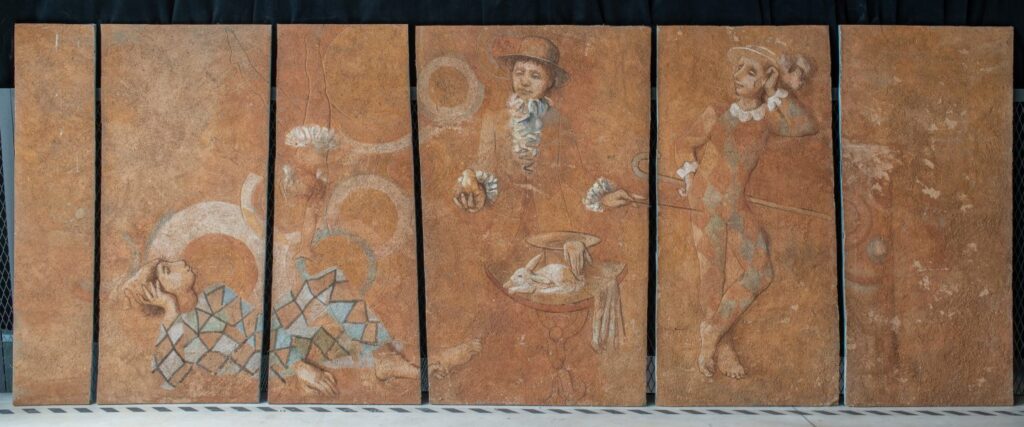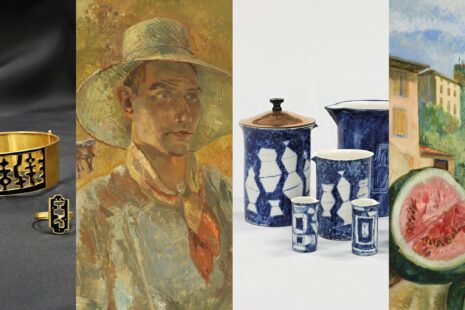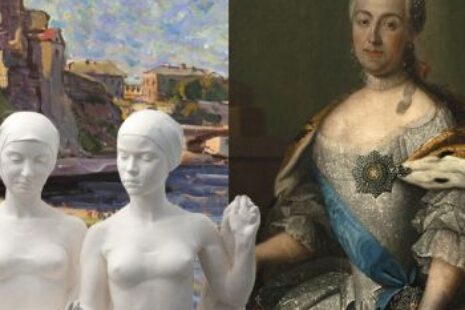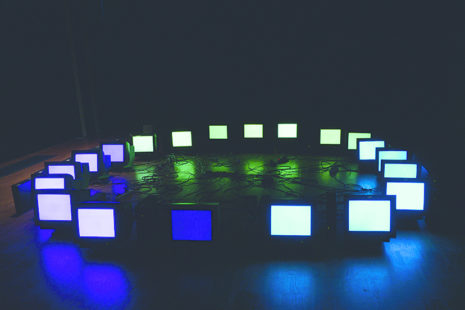The exhibition introduces the fascinating collection of monumental painting designs from 1962–1995 stored at the EKA Museum, which includes design proposals for various works in all classical techniques of monumental painting: fresco, sgraffito, mosaic and stained glass. In order to highlight the technical singularity of monumental painting, 12 completed works are displayed at the exhibition, including stained glasses and mosaics made as student works (and graduation projects) as well as two works removed from the former EKA building on Tartu Road before its demolition: a circus-themed fresco by Valentin Vaher and fragments from Urve Dzidzaria’s remarkable sgraffito which covered the walls of the canteen. Screened at the exhibition will be a video by Kai Kaljo, introducing the fate and stories of destruction of monumental paintings through interviews with artists.
The exhibition features 46 artists (and also a few anonymous authors) with a total of 138 works. Most of the works at the exhibition come from the collections of the EKA Museum, added by works in the private collections of the artists themselves. The oldest exhibit is a fragment of the fresco mural by Dolores Hoffmann removed from Rahu Cinema before its demolition (1962–1963); the most recent work displayed is part of Ivika Luisk’s graduation project in mosaic technique (1995).
The exhibition is accompanied by a 160-page catalogue which provides an overview to the teaching of monumental painting at the EKA in 1962–1995 illustrated with documentary photographs and reproductions. It also sheds light on the fortunate occasions when students were able to realise their ideas in buildings. Worth mentioning here is Dolores Hoffmann’s collaboration with Aate-Heli Õun, lecturer of interior architecture. The catalogue also includes the list of artists graduated in the specialty monumental painting and their graduation works, and provides information on student works that cannot be brought to the exhibition hall. Monumental paintings finished as integral part of architecture are introduced through photographs. During our research we managed to identify 44 works of which only half are available today. The catalogue and its lists of monumental paintings are compiled by Reeli Kõiv. She is also the author of the overview article printed the catalogue.
The catalogue also addresses the fate and status of monumental painting today. In addition to the essay based on Kai Kaljo’s memories, various opinions emerge in a discussion group of painters moderated by Gregor Taul, where artists from different generations talk about monumental painting, its possibilities and future place, drawing on their personal experience.The catalogue is designed by Tiina Sildre, edited by Kristi Metste and translated into English by Epp Aareleid.
Curator of the exhibition: Reeli Kõiv
Exhibition design: Kristi Kongi
Graphic design: Pärtel Eelmere
Exhibition team: Heldur Lassi, Mihkel Ilus, Karmo Migur, Hilkka Hiiop, Taavi Tiidor
Many thanks to: Cultural Endowment of Estonia, OÜ JÄRSI, OÜ Grano Digital, EAA Gallery, Dolores Hoffmann, Kai Kaljo, Epp Kubu, Gregor Taul, Tiina Sildre, Kristi Metste, Epp Aareleid, Enn Põldroos, Tiit Pääsuke, Urve Dzidzaria, Eva Jänes, Mari Roosvalt, Uno Roosvalt, Kaarel Kurismaa, Jüri Kask, Heldur Lassi, Hilja Nairis-Piliste, Saima Vaitmaa, Robert Suvi, Üüve Vahur, Heli Tuksam, Valentin Vaher, Andrei Lobanov, Valev Sein, Kalli Sein, Tiina Tammetalu, Inga Aru, Ivika Luisk, Rene Aua, Kaido Ole, Kai Kallas, Heinart Puhkim, Ilmar Köök, Tiina Meeri, Heie Marie Treier, Aate-Heli Õun, Epp Maria Kokamägi, Iris Uuk, Reet Reidak, Hilkka Hiiop, Solveig Jahnke, Sirli Aavik, Pire Sova, Pärtel Eelmere
Gallery name: EKA Gallery
Address: Põhja pst. 7, Tallinn
Opening hours: Tue-Sat 12:00 - 18:00
Open: 08.10.2020 - 05.11.2020







